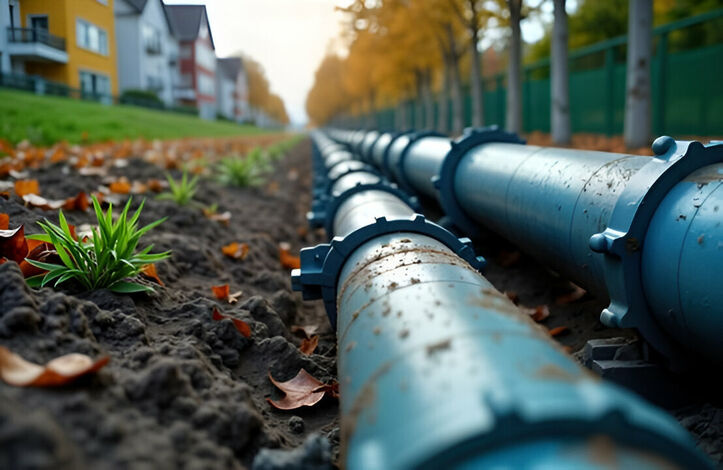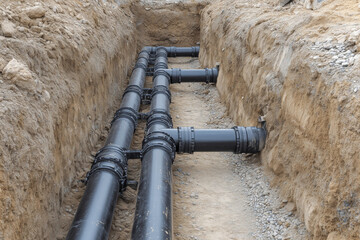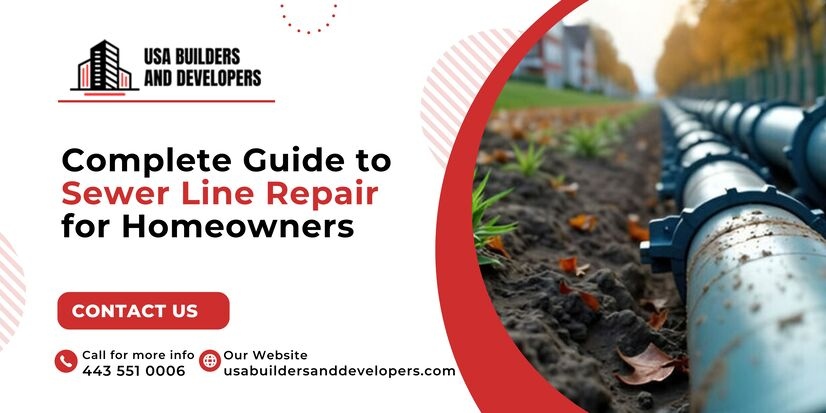A damaged sewer line is one of the most stressful problems a homeowner can face. When wastewater stops flowing correctly, it can quickly lead to property damage, unpleasant odors, and serious health hazards. Understanding the Sewer Line Replacement Cost helps you prepare financially and make informed decisions. USA Builders and Developers provides expert guidance and professional sewer line services to help homeowners navigate repairs and replacements with confidence.
This guide breaks down repair expenses, common issues, replacement options, and how to budget for the entire project.
Why Sewer Line Replacement Matters
Your sewer line plays a major role in keeping your home safe and functional. It carries wastewater from sinks, toilets, and drains to the municipal sewer system. When a problem appears, it often requires immediate attention.
Common reasons for sewer line failure include:
- Tree root intrusion
- Corrosion or pipe deterioration
- Soil shifting
- Heavy ground movement
- Old, outdated materials like clay or cast iron
- Blockages and sewer backups
Early intervention reduces repair costs, improves home safety, and prevents extensive damage to landscaping and flooring.
Average Sewer Line Replacement Cost
The Sewer Line Replacement Cost depends on multiple factors such as the length of the pipe, access difficulty, material, method, and location of the damage. On average, homeowners pay between $3,000 and $12,000 for a full replacement.
Below is a detailed cost breakdown for better clarity.
Sewer Line Repair & Replacement Cost Table
| Service Type | Average Price Range |
|---|---|
| Basic sewer pipe repair | $500 – $2,500 |
| Cost to fix sewer backup | $250 – $1,000 |
| Sewer backup repair cost (severe) | $2,000 – $6,000 |
| Trenchless sewer line replacement | $4,000 – $15,000 |
| Traditional excavation replacement | $3,000 – $12,000 |
| Sewer pipe replacement (per foot) | $50 – $250 per foot |
Prices vary based on labor, materials, depth of the pipe, and complexity of the job.
Factors That Affect Sewer Line Replacement Cost
Several variables impact the final bill. Understanding each one helps homeowners prepare financially.
1. Pipe Length
The longer the damaged line, the more materials and labor are required. Most homes have sewer lines between 30 and 100 feet, which heavily influences the total cost.
2. Pipe Material
Different pipe materials come with different price points:
- PVC – affordable and durable
- ABS – slightly more expensive but strong
- Cast iron – costly but robust
- Clay – older and often replaced entirely
Choosing the right material affects both pricing and future maintenance needs.
3. Depth and Accessibility
If the sewer line is easy to reach, costs remain moderate.
But if it is:
- Under a driveway
- Beneath trees
- Deep underground
- Located under heavy concrete
… the price increases significantly due to the added effort and equipment required.
4. Type of Repair Method
Two main methods are used:
A. Traditional Excavation
This involves digging a trench to access the entire pipe. It is effective but messy, time-consuming, and may damage landscaping or pavements.
B. Trenchless Technology
Methods like pipe bursting or pipe lining avoid major digging. These methods cost more but save time and protect your yard.
5. Labor Charges
Labor varies by location and complexity of the job. Emergency services, nighttime repairs, or holiday calls may increase costs.
Understanding the Cost to Fix Sewer Backup
A sewer backup is one of the first signs of sewer line trouble. The cost to fix sewer backup depends on the severity of the issue.
Minor backups caused by small clogs may cost $250–$1,000, while severe backups linked to pipe damage can cost $2,000–$6,000 or more.
Early detection saves money. Watch for signs like:
- Gurgling drains
- Slow water flow
- Foul odors
- Water pooling around floor drains
- Frequent clogs
If you notice these symptoms, contact a professional immediately.
Sewer Pipe Repair vs. Sewer Pipe Replacement
Not all sewer issues require a full replacement. Sometimes, sewer pipe repair is enough.
When Repair Is Suitable
- Minor cracks
- Small leaks
- Isolated clogs
- Early-stage corrosion
Repairs typically cost less and can be done quickly.
When Replacement Is Necessary
- Large cracks
- Severe corrosion
- Multiple leaks
- Pipe collapse
- Outdated material pipes
- Heavy tree root invasion
In these cases, sewer pipe replacement is more cost-effective long-term and prevents repeated issues.


How Professionals Replace a Sewer Line (Step-by-Step)
Knowing what happens during the process helps homeowners feel prepared and avoid surprises.
1. Inspection With a Sewer Camera
A specialized camera identifies the cause of the issue, the condition of the pipe, and the exact location of blockages or breaks.
2. Cost Estimate and Plan
Professionals provide a detailed plan covering:
- Method of repair
- Required materials
- Timeline
- Total Sewer Line Replacement Cost
3. Permits and Approvals
Local permits are necessary, especially for excavation. Your contractor usually handles this.
4. Excavation or Trenchless Entry Points
Depending on the chosen method:
- Access holes are dug
- Traditional trenches may be opened
5. Old Pipe Removal
Damaged sections are removed carefully to avoid harming surrounding structures.
6. Installing New Sewer Pipe
A new pipe is installed using either traditional or trenchless methods.
7. Backfilling and Site Restoration
Once the new pipe is installed, teams:
- Refill trenches
- Level soil
- Repair landscaping or concrete if needed
8. Final Testing
The line is flushed, inspected again, and tested to ensure proper function.
Tips to Reduce Sewer Line Replacement Cost
You can take several steps to keep costs manageable.
- Schedule Routine Inspections: Early detection prevents expensive damage and full replacements.
- Avoid Planting Trees Near Sewer Lines: Tree roots are a leading cause of sewer pipe damage.
- Use Water Wisely: Overloading drains can weaken pipes over time.
- Install Drain Screens: This reduces debris entering your sewer line.
- Choose Trenchless Replacement (When Possible): While the initial cost may be higher, it saves money on restoration.
Is Sewer Line Replacement Covered by Insurance?
In most cases, homeowners insurance does not cover sewer line replacement unless the damage is sudden and accidental (like from an explosion or extreme weather event).
Damage caused by:
- Wear and tear
- Aging
- Corrosion
- Tree roots
…is typically not covered.
However, you can purchase sewer line coverage as an add-on with many insurance providers. It may reduce out-of-pocket expenses significantly.
Final Thoughts
Replacing a sewer line is a major home repair project, but understanding the Sewer Line Replacement Cost helps you make smart, informed decisions. Whether you’re dealing with a backup, blockage, or failing pipe, knowing the costs, methods, and repair options gives you confidence throughout the process.
A healthy sewer line protects your home, prevents damage, and ensures long-term peace of mind. If you notice early warning signs or suspect a sewer issue, contact a professional right away to avoid more expensive repairs later.
Have Questions? Call Us Now!
We’re here to help—quick answers, friendly service, anytime you need!

